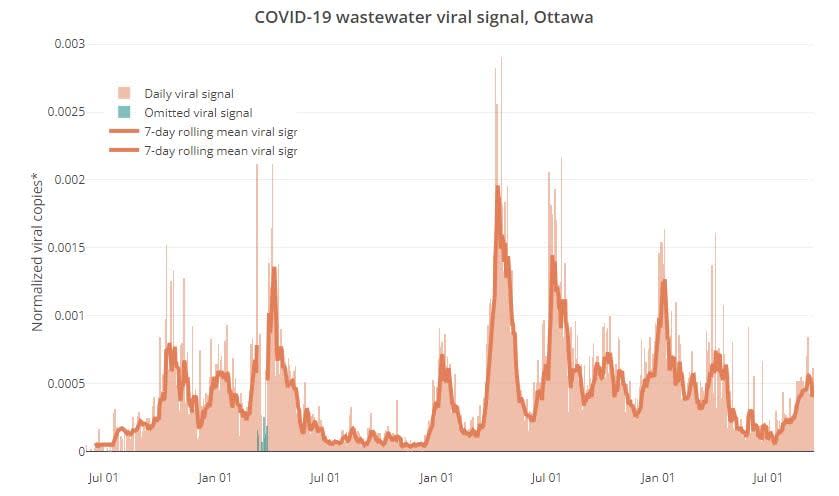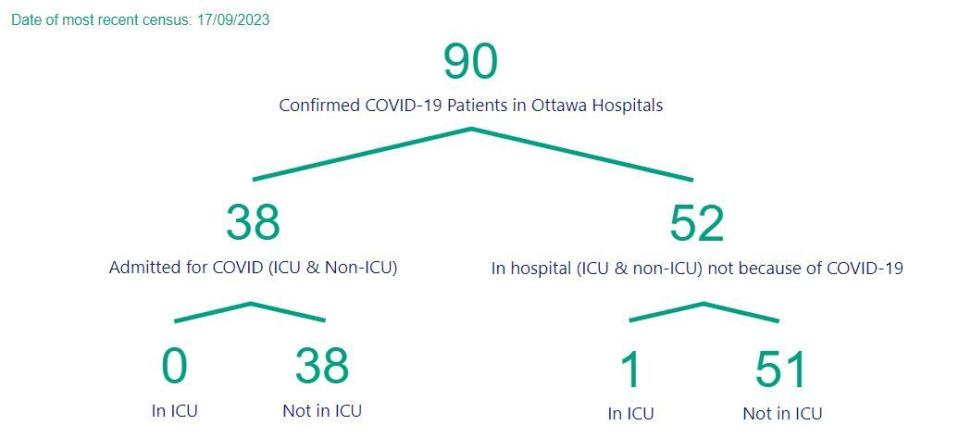Ottawa's COVID levels remain high, Kingston area indicators on the rise

Recent developments:
Ottawa's COVID-19 trends are mostly high and stable.
The Kingston area is also seen as being at high risk for respiratory illness.
Seven more local COVID deaths have been reported.
The latest
The city's pandemic numbers to watch are mostly high and stable in this week's Ottawa Public Health (OPH) update, like last week.
Because of this, OPH again says the city's health-care institutions are at a high risk from respiratory illnesses, like they would be in December, January and February.
OPH is expecting the 2023-2024 respiratory virus season to be similar to its last, when COVID-19, flu and respiratory syncytial virus (RSV) surged at the same time to press health-care staff and the health system to the point the Red Cross had to help.
Experts recommend that people wear masks, keep their hands clean, gather in well-ventilated and less-crowded spaces, stay home when sick and keep up to date with COVID and flu vaccines to help protect themselves and vulnerable people.
Both COVID-19 and flu vaccines are expected to be available for the general public in Ottawa around the end of October, with earlier availability for people at higher risk of serious health problems.
Wastewater
Data from the research team shows that as of Sept. 14, the average coronavirus wastewater level has been stable for about 10 days after slowly rising for nearly two months.
OPH considers this to be high.

Researchers have measured and shared the amount of novel coronavirus in Ottawa's wastewater since June 2020. The most recent data is from Sept. 14, 2023. (613covid.ca)
Hospitals
The average number of Ottawa residents in local hospitals for COVID-19 in the last week is slightly higher at 37, with no patients in an ICU. Its 18 new patients in the previous week is low, according to OPH.
A separate count that includes patients who tested positive for COVID after being admitted for other reasons, were admitted for lingering COVID complications and were transferred from other health units, is stable.

Ottawa Public Health has a COVID-19 hospital count that shows all hospital patients who tested positive for COVID, including those admitted for other reasons and who live in other areas. (Ottawa Public Health)
Tests, outbreaks, deaths and vaccines
The city's weekly average test positivity rate is about 19 per cent and has stayed within that general range for the last month. OPH considers this to still be very high.
OPH says there are 27 active COVID outbreaks, also a high number and stable from last week. More than half are in care homes.
The health unit reported 272 more COVID cases in the last week and three more COVID deaths, all people age 70 and above.
The next OPH vaccination update is expected early next month.
Across the region
Spread
The Kingston area's health unit says its COVID trends are rising at moderate to very high levels and it's now in a high-risk time for transmission.
Its average coronavirus wastewater reading is considered very high and rising. Other available wastewater trends outside Ottawa are low in Cornwall and Hawkesbury and stable in Smiths Falls and Brockville.
The average COVID-19 test positivity is a stable 13 per cent in the Eastern Ontario Health Unit (EOHU) and rises to 13 per cent in the Kingston area.
Hospitalizations and deaths
The Kingston area's health unit says it has a high and rising 22 active COVID patients in its hospitals, including anyone living in a different health unit.
Other eastern Ontario health units around Ottawa — Renfrew County, the EOHU and Leeds, Grenville and Lanark counties — report 10 combined residents in hospital for COVID treatment, with one in intensive care.
Like Ottawa, Hastings Prince Edward (HPE) Public Health shares a weekly average: seven hospitalizations in its most recent update, which is stable. No patient is in intensive care.
Western Quebec has a stable 16 hospital patients with COVID.
Quebec reported three more COVID deaths in the Outaouais for a total of 492. HPE reported its 125th such death.


